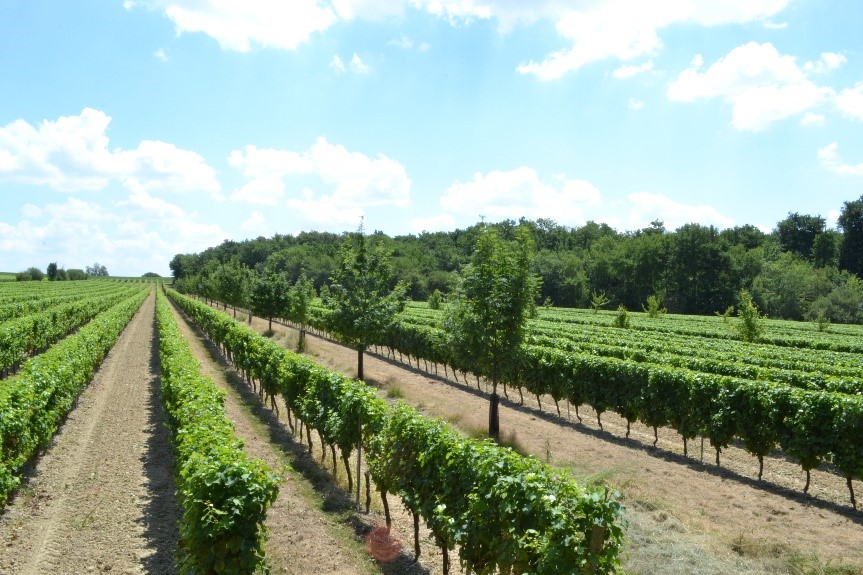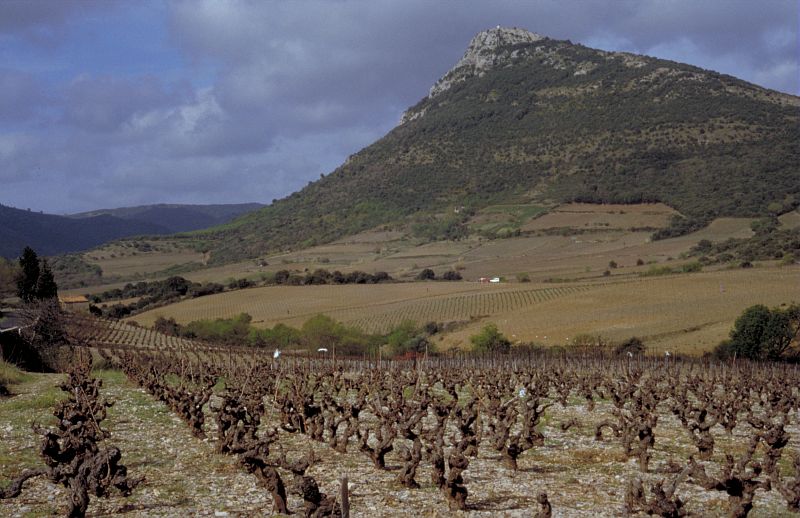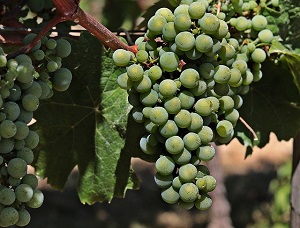Agroforestry / Vitiforestry

Agroforestry refers to the association of trees and crops or animals on the same agricultural plot. It is an ancestral practice, widespread throughout the world and dormant in the West due to the rise of agricultural machinery and phytosanitary products, which has led to an intensive cultivation requiring systematic removal of trees. These practices include field crops, livestock (sylvo-pastoralism), perennial crops such as vines and arboriculture.
The vitiforestery is the agroforestry applied to the viticulture and therefore the association of the plantation of trees with the cultivation of the vine. Agroforestry in viticulture could offer various advantages, notably through ecosystem services such as the improvement of biodiversity including soil, mitigation of climate excesses, carbon storage, the recovery of additional biomass, timber production. There are different types of development: rows of trees interspersed between rows of vine, shrub hedge bordering a plot or interspersed between islets of vine, isolated trees planted within the row of vine. Different tree or shrub species or different distances between tree lines and row of vines may be selected based on the operator’s objective. (1)
The competition between trees and vines must be taken into account. This competition can be for water, soil nutrients or light. A French study shows that trees interspersed with vines have no direct effects on the nutrition of vines (2).
The association of trees in a vineyard plot will lead to changes in the micro-climate of vine plants:
- The shade of the trees has an effect on the radiation received by the vine. This particularly impacts the first or first 2 rands north of the tree row. (3)
- The trees will also change the air circulation: the reduction of turbulence is effective over a distance of 2 to 4 times the height of the tree in the axis of the prevailing winds. The presence of isolated trees, particularly when they are bare at the base, can contribute to increase turbulent flows and lead to a decrease in summer temperature peaks, and a reduction in the duration of foliar humectation (Thèse Juliette Grimaldi, 2019).
- Changing the water cycle in the vicinity: Recycling of deep water resources to the atmosphere occurs, resulting in increased relative humidity and cooling of the air. The water is trapped by moisture condensation (dew) and the rain is intercepted (3-5mm). (1)
In agriculture, a plot in agroforestry is considered from 100 trees per hectare. However, in viticulture, it is advisable to plant a low density of trees (30 to 40 per hectare). In this case, there is no competition over the first 10 years of co-planting based on the results of the Vitiforest project (no effect on the vigour and composition of the grapes). (4)
Few technical and economic references are available for agroforestry systems, let alone applied to viticulture. Four types of economic impacts are highlighted: (i) the cost of planting and maintaining trees, (ii) additional costs for the maintenance of the vine, (iii) profits from the valorization of trees or their products, and (iv) environmental amenities and services, comparing a monoculture system and an agroforestry viticultural system. (4)
Finally, vitiforestry meets, from a societal point of view, the growing needs of consumers to have a quality product, with a minimal impact on natural resources.
|
Adaptation effect of the solution |
Mitigation effect of the solution |
||
|
+ |
- |
+ |
- |
|
All the reasons why the solution is an adaptation to CC. Why would the solution make a system stronger? |
Anything that weakens the system against the CC would make it more vulnerable |
Mitigation effects of the solution, does the solution have a mitigation effect? |
Or, on the contrary, would the solution encourage the CC? |
|
Shading Temperature reduction when heat waves in some cases No negative effects on production in the first 10 years (4) |
Loss of yield on production surfaces due to potential competition vine/tree for light, water and nutrients (from 15 years of complantation and especially when trees are older) (5) |
Carbon sequestration |
|
(1) IFV, 2018. Itinéraires n°28 – Agroforesterie et viticulture.
(2) Assessment of biodiversity and agronomic parameters in two Agroforestry vineyards. Josépha Guenser, Emilie Bourgade, Marc Vergnes, Thierry Dufourcq, Séverine Mary . E3S Web Conf. 50 01013 (2018) DOI:10.1051/e3sconf/20185001013
(3) Grimaldi, Juliettz and Fieuzal, Rémy and Pelletier, Charlotte and Bustillo, Vincent and Houet, Thomas and Sheeren, David Microclimate patterns in an agroforestry intercropped vineyard: First results. (2016) In: 3ème congrès européen de l'agroforesterie - EURAF 2016, 23 May 2016 - 25 May 2016 (Montpellier, France). https://www.repository.utl.pt/bitstream/10400.5/17543/1/EURAFIIIConf_Grimaldi_J_et_all_page_191_194.pdf
(4) Bourgade, E., Alonso Ugaglia, A., Bustillo, V., Dufourcq, T., Grimaldi, J., Guenser, J., Montagne, V., Ranjard, L., 2020. VITIFOREST : Évaluation de l’impact de l’arbre agroforestier en contexte viticole 79, 471–497.
(5) Bellassen V., Cardinael R., Mézière D., et al., 2019a. Développer l’agroforesterie dans les parcelles cultivées. In: Le potentiel de l’agriculture et de la forêt françaises en vue de l’objectif d’un stockage de carbone dans les sols à hauteur de 4 pour mille. (Coord. S. Pellerin), INRA.
Relations
- Network
- List
- Geolocation
- More
Un article dans TheConversation montre que face au changement climatique les vins d'appellation doivent s'appuyer sur une cogestion adaptative de leur terroir
- More
Changement climatique : les ODG favorables à des accompagnements
Dans le cadre du projet VitiREV (volet recherche participative & observatoires ; 2019-2027), un groupe de chercheurs (UMR EGFV de l’Institut des Sciences de la Vigne et du Vin à Villenave d’Ornon) a conduit une enquête auprès des représentants des ODG viticoles de Nouvelle-Aquitaine. L’enjeu : recue
- More
Les vins d'appellations vont-ils disparaître ou renaître avec le changement climatique ?
En France, plus de de 90% de la production des vins est signalée par des indications géographiques, AOP ou IGP, mais le changement climatique vient remettre en cause les liens construits historiquement entre es vins et leurs territoires, inscrits dans des cahiers des charges.
- More
Promote shade over the vineyard
To reduce water stress, and to fight sunburn and roasting, the idea of promoting shading of the vineyard is an interesting alternative


